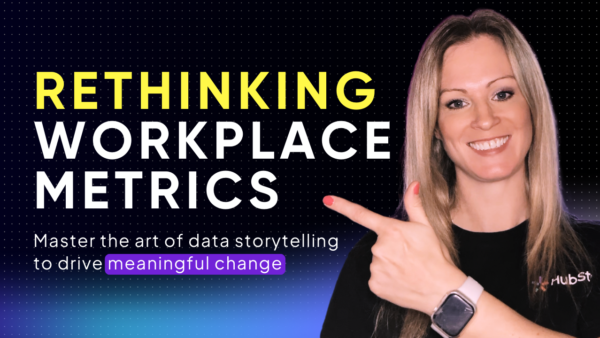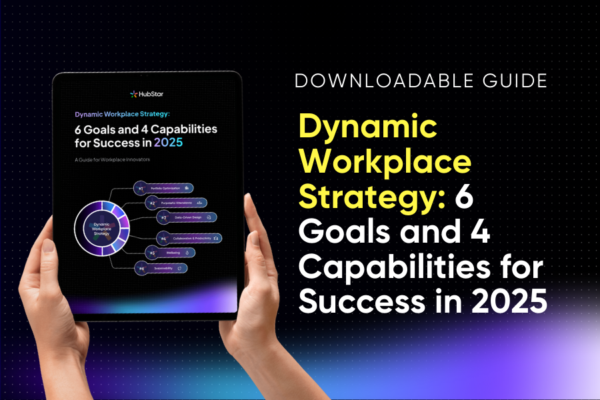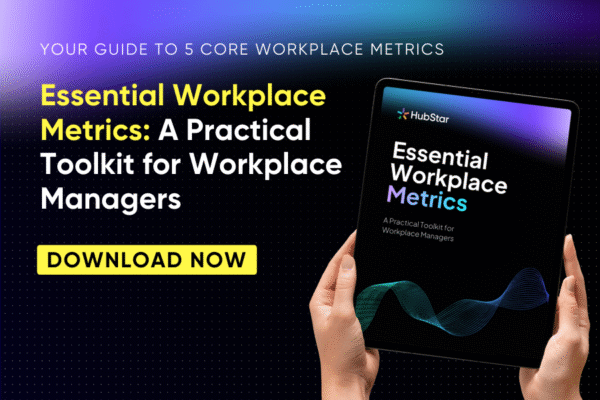Policy Guide
Failed Hybrid Policy Guide: From Crisis to Competitive Advantage
A failed hybrid work policy can have catastrophic consequences for your organization. But if this happens, all hope isn't lost. In this guide, we'll cover what to do if your organization's hybrid work policy fails - why it happens, real-world examples, how to create and implement policies that actually stick, and red flags that a crisis is around the corner.

Your hybrid work policy could be failing, and you might not even know it.
One in five employees don’t follow return to office mandates, according to an October 2024 survey.
In this survey, 1,030 employees revealed that only 78% consistently comply with return-to-office policies. The remaining 22% operate by their own rules: 18% occasionally skip required office days, 2% rarely comply, and 1% have essentially opted out entirely.
Even more alarmingly, 40% of managers know about employees ignoring RTO mandates but are either unwilling or powerless to address it.
This isn’t just about empty desks. When policies exist on paper but not in practice, the consequences cascade through every aspect of your organization.
For HR: Employees complying with RTO mandates grow resentful from witnessing under the table hushed hybrid arrangements. Policies become sources of inequity rather than clarity.
For Workplace Experience and CRE teams: Space planning decisions are based on assumptions instead of accurate data. Those “low utilization” metrics might reflect policy violations, not actual space needs. Real estate optimization becomes impossible when you can’t predict who will show up.
For C-Suite Executives: You lose the productivity gains and culture benefits you invested in. Your highest performers (who have the most options) are often the most likely to resist rigid mandates, putting your entire talent strategy at risk.
The ripple effects include fragmented collaboration, declining manager effectiveness, diminished ROI on office investments, and competitive disadvantage as flexible competitors poach your talent.
So what does success look like?
Imagine having hybrid policies that employees actually want to follow, built on real data about how work gets done instead of assumption. Organizations that achieve this alignment see:
- Policy compliance without surveillance or heavy enforcement
- Improved collaboration
- Higher employee satisfaction and retention rates
- Optimized real estate utilization
- Competitive advantage in talent acquisition and retention
The companies addressing this crisis strategically rather than punitively are building stronger, more resilient workplace cultures while their competitors struggle with unenforceable mandates.
So let’s get into it. How can you spot and fix a hybrid policy crisis?
Keep reading for:
- The 5 fatal flaws that doom hybrid work policies from the start
- Why a hybrid policy becomes a crisis
- Real case studies of policy failures that cost companies million
- Emergency triage steps to stop talent hemorrhaging immediately
- The adaptive policy framework that builds hybrid work through buy-in, not force
- An implementation framework
- How to future-proof your new hybrid policy
- Early warning signs to spot policy breakdown before it becomes a crisis
For workplace leaders wanting to make sure their hybrid policies don’t become another cautionary tale, the solution isn’t stricter enforcement, but smarter policy design based on how work actually happens.
Let’s dive into why traditional policies fail and how to build ones that actually work.
Why Hybrid Policies Fail: 5 Fatal Flaws
Here’s the uncomfortable truth: even when companies go nuclear with full-time office mandates, they’re still watching employees slip through the cracks.
So why do even the most draconian return-to-office policies crumble? It comes down to five design flaws that doom these mandates from day one.
Do Return to Office Mandates Actually Rebuild Social Connection?
It seems like everyone is slapping on heavy handed return-to-office mandates to improve social connection and collaboration. But do they actually work?

Flaw #1: The force vs. flow problem
Most office mandates operate on the assumption that presence equals productivity. It’s the corporate equivalent of believing that standing in a garage makes you a car.
Companies craft policies based on what executives think collaboration should look like, not how it actually happens. They mandate “Collaboration Tuesdays” without checking if Tuesday is when the development team actually needs to brainstorm, or if the sales team is buried in client calls that day.
Real collaboration has a natural rhythm. Some teams gel better on Mondays when energy is high. Others find their groove mid-week when the chaos settles. But rigid mandates ignore these organic patterns, forcing square pegs into round holes and wondering why nothing fits.
The result is that teams show up physically but check out mentally, going through the motions of “collaboration” while their actual productive work happens in Slack channels and Zoom calls anyway.
Flaw #2: Disconnect from actual work needs
Here’s where it gets really messy. Most hybrid policies are designed by people who don’t actually do the work they’re regulating.
Take software developers. Their deep-focus coding sessions require uninterrupted blocks of time, something that’s often easier to achieve at home than in an open office buzzing with “synergy.” Yet they’re mandated to be in-office for the same number of days as the business development team, who genuinely benefit from face-to-face relationship building.
Or consider the finance team during the end of quarter madness. They need intense concentration and quick access to multiple systems. Forcing them into the office during their most critical work period isn’t collaboration. It’s sabotage, and will be perceived the same way too.
The disconnect becomes glaring when you realize that many policies are driven by real estate costs rather than work requirements. “We’re paying for this office space, so people better use it” isn’t a productivity strategy. it’s the sunk cost fallacy in action.
Flaw #3: The enforcement paradox
When a mandate is issued, managers are caught in an impossible bind: enforce policies that drive away top talent, or turn a blind eye and undermine organizational credibility.
Picture this scenario: Your star performer, the one who consistently delivers exceptional results, tells you they’re considering other opportunities because of the rigid office mandate. Do you:
A) Stick to policy and risk losing them to a competitor offering flexibility?
B) Quietly allow exceptions and create the very hushed hybrid arrangements that breed resentment?
Most managers choose option B, creating a shadow system where the real policy is “it depends on how valuable you are.” This isn’t malicious, it’s survival. But it transforms clear policies into murky favoritism, where the rules seem to bend based on your performance review score.
The enforcement paradox explains why 40% of managers ignore non-compliance. They’re not being negligent, they’re being pragmatic in a system that sets them up to fail.
Flaw #4: Communication Breakdown
Most office mandates are announced, not discussed. They arrive via company-wide email with the subtlety of a sledgehammer: “Effective immediately, all employees will return to the office five days per week.”
But here’s what’s missing: the why that actually resonates.
“We need better collaboration” feels hollow when employees have been collaborating successfully for years. “Company culture” rings false when the mandate itself damages culture by ignoring employee input. “Productivity concerns” fall flat when performance metrics don’t support the claim.
The communication breakdown happens because of messaging, not dialogue. Policies created in boardroom echo chambers, without input from the people who will live with them daily, are destined to face resistance. When employees feel unheard, they stop listening.
Even worse, many companies fail to connect office presence to specific business outcomes. Without clear links between being in-office and achieving meaningful results, mandates feel arbitrary.
Flaw #5: Set-and-forget mentality
One of the biggest mistakes is treating hybrid policies like furniture: set them up once and assume they’ll work forever.
This rigidity becomes a fatal flaw when policies don’t account for seasonal variations, workplace patterns and preferences or external factors.
The set-and-forget mentality also ignores feedback loops. When policies aren’t working, there’s no dynamic mechanism to adjust course. Instead, companies double down on failed approaches, creating more elaborate enforcement mechanisms rather than questioning whether the policy itself needs revision.
What is Dynamic Workplace Management?
The workplace AND the right hybrid policies change faster than trending sounds on Tik Tok, but dynamic workplace management can keep you a step ahead.

The Common Thread
Each of these flaws stems from the same root problem: designing policies based on assumptions rather than reality. Companies create mandates that sound logical in theory, but crumble when they meet the messy complexity of actual work.
The organizations that avoid these fatal flaws don’t start with mandate, but with understanding. They ask what work truly requires in-person attendance, when collaboration happens naturally, and how to create policies that support rather than constrain productivity.
The goal isn’t 100% policy adherence, but performance. And policies that fight against human nature and the realities of work will always fail.
Where Did the Hybrid Policy Crisis Come From?
Let’s take a look at exactly why people are ignoring RTO mandates:
High performers have better options.
Top performers are often your biggest policy rebels. The same people who consistently exceed targets, mentor junior staff, and drive innovation are the ones most likely to ghost your office mandates.
That’s because high performers have options. They know their worth, and they’re not afraid to explore opportunities with companies that trust them to work effectively regardless of location. A December 2024 study actually found that S&P 500 firms with strict RTO mandates saw disproportionately higher turnover rates among senior, skilled and female employees.
Managers are stuck between a rock and a hard place.
Remember that Stanford research showing 40% of managers ignore non-compliance? That’s not negligence, but survival, and turnover rates would probably be a lot worse without it.
Picture the impossible position these managers face: Sarah from the design team is crushing her deliverables while working from her home studio three days a week, but company policy says she should be in-office five days. Do you:
- Enforce the policy and risk losing your top designer?
- Look the other way and hope nobody notices?
- Escalate to HR and become “that manager” who can’t handle their team?
Most choose option two, creating a shadow economy of unspoken agreements. “Don’t ask, don’t tell” becomes the unofficial management strategy, turning clear policies into murky judgment calls.
Hushed Hybrid: Harmless or Harmful?
What people know can't hurt them - or can it? In this post, we take a look at hushed hybrid - what it means for your organization, the harm it could be doing, and how to fix it.

Quiet quitting starts here.
Non-compliance is often the first symptom of broader disengagement.
If the office mandate feels arbitrary and disconnected from actual work needs, the company’s entire credibility comes into question. It’s a slippery slope from “I’ll skip the mandatory office day” to “I’ll do the bare minimum in everything.”
This passive resistance spreads like a workplace virus. One person’s successful policy evasion becomes another’s permission slip. Soon, you’ve got entire teams operating by unwritten rules that contradict official policy.
And with only 23% of the workforce feeling engaged according to Gallup’s 2024 State of the Workplace Report, it’s a very bad time for hushed hybrid to start adding fuel to the fire.
The commuting cost crisis is only getting worse.
The compliance crisis isn’t evenly distributed. Companies with offices in expensive cities see higher non-compliance rates. With commuting costs, the economic incentive to avoid the office becomes overwhelming. Over half of UK employees, for example, cite petrol as their highest cost, and 69% say their work-related costs have increased over the last year.
Similarly, teams with global colleagues already accustomed to virtual collaboration show less office compliance. If you’re joining video calls with teammates in three time zones anyway, the “collaboration” argument for being in-office feels pretty thin.
When Hybrid Policies Fail: Real Cautionary Tales
These aren’t theoretical scenarios or hypothetical warnings. As a workplace leader, studying these failures can help you avoid similar pitfalls while building credibility with both leadership and employees.
Case Study 1: Amazon’s 91% Employee Dissatisfaction Crisis
Company: Amazon (September 2024)
Policy: Mandatory 5-day return-to-office for all corporate employees starting 2025
When Amazon announced its full return-to-office mandate, leadership likely expected some pushback. What they got was a talent retention crisis that made headlines worldwide.
A Blind survey of 2,500+ Amazon employees revealed staggering dissatisfaction levels: 91% opposed the new policy, 73% were actively considering quitting, and 32% personally knew someone who had already left because of the mandate.
What went wrong: The policy emerged as a top-down directive without meaningful employee consultation. Despite years of successful hybrid performance during and after the pandemic, leadership provided no data demonstrating that productivity had declined or that collaboration had suffered under flexible arrangements.
The ongoing fallout continues to unfold: Over 500 AWS employees sent a formal protest letter to leadership. The “rage-applying” phenomenon emerged as employees actively sought positions with more flexible competitors. Talent acquisition became significantly more challenging as other tech companies capitalized on Amazon’s rigid stance.
The measurement gap: Amazon implemented this sweeping change without presenting evidence that hybrid work had harmed productivity or collaboration. This absence of supporting data made the mandate feel arbitrary and undermined employee trust in leadership decision-making.
Prevention insight: Attendance analytics could have identified which specific roles and teams actually benefited from full-time office presence, allowing for targeted rather than blanket requirements.
Amazon's Full-Time RTO Mandate: Perspectives and Data
Since Amazon announced its full-time RTO mandate, the backlash has been swift. 73% of Amazon employees reported they were considering quitting. But what does the data say about the benefits of being in the office full time? Does it supercharge collaboration or stifle productivity?

Case Study 2: Nationwide’s £350,000 Legal Disaster
Company: Nationwide Building Society (2023)
Policy: Eliminated work-from-home arrangements, required all staff return to office
Nationwide’s experience demonstrates how policy changes can create significant legal and financial exposure when implemented without proper consideration of individual circumstances.
What went wrong: The organization failed to adequately consider disability accommodations and individual employee situations when eliminating flexible work arrangements.
The costly fallout: The employment tribunal awarded £350,000 to manager Jayne Follows for unfair dismissal and discrimination. This case established legal precedent for similar situations, created lasting reputational damage, and required substantial additional HR and legal resources to manage.
The measurement gap: Nationwide implemented the policy without assessing individual performance records or accommodation needs. This lack of personalized evaluation contributed to the discriminatory impact that led to the tribunal ruling.
Prevention insight: Workplace analytics can help identify which employees and roles maintain or exceed performance standards in remote arrangements, providing objective data to support accommodation decisions and prevent discriminatory outcomes.
Case Study 3: SAP’s Employee Rebellion
Company: SAP (German software giant, 2024)
Policy: Return-to-office mandate for global workforce
SAP’s experience illustrates how even well-established companies can face organized employee resistance when policies feel disconnected from work realities.
What went wrong: 5,000 employees signed a coordinated protest letter opposing the mandate, representing unprecedented organized pushback against company policy.
The fallout damaged multiple areas: Internal morale and trust in leadership declined significantly. The company faced competitive disadvantage in talent markets where flexibility had become a key differentiator. Policy credibility suffered as leadership appeared disconnected from employee needs and work realities.
The measurement gap: SAP provided no comparative data on collaboration effectiveness or productivity differences between remote and office work, making the mandate appear arbitrary rather than evidence-based.
Prevention insight: Measuring actual team collaboration patterns and productivity outcomes can prevent policies that contradict successful existing work arrangements.
Case Study 4: Federal Government’s Implementation Chaos
Company: U.S. Federal Agencies (2025)
Policy: Executive order requiring full-time return to office
The federal government’s experience demonstrates how policy changes can fail due to basic logistical oversights.
What went wrong: Agencies lacked sufficient office space and resources to accommodate returning workforce, creating immediate operational problems.
The ongoing chaos includes: Office shortages and logistical confusion across agencies. Employee unions are challenging the legality of breaking existing telework agreements. Productivity has been disrupted during the chaotic transition period. Implementation has been described as “messy” across multiple agencies.
The measurement gap: Agencies implemented the mandate without conducting capacity planning or space utilization analysis, leading to predictable infrastructure failures.
Prevention insight: Occupancy analytics can prevent infrastructure crises by ensuring adequate space and resources before implementing policy changes.
Common Failure Patterns
These cases reveal consistent patterns that workplace leaders can learn from, including:
❌Assumption-based decisions replace data-driven policy development
❌Legal and accommodation risks receive insufficient consideration during planning
❌Employee consultation gets bypassed in favor of executive directive
❌Infrastructure capacity goes unassessed before implementation
❌Performance correlation between location and productivity remains unmeasured
The Critical Missing Element
Every failure shares one fundamental flaw: decisions were made without comprehensive measurement and analysis. These organizations lacked understanding of current space utilization, work requirements for different roles, employee performance patterns across work arrangements, legal and accommodation obligations, and infrastructure readiness for change.
How Measurement Prevents Disasters
Comprehensive workplace analytics are the foundation for successful policy development. Space utilization data reveals what currently works before making changes. Capacity planning prevents infrastructure failures. Performance correlation identifies which roles genuinely require office presence. Legal compliance tracking prevents discrimination issues. Continuous monitoring enables quick adjustments before problems become crises.
These cautionary tales demonstrate that successful workplace policies require careful measurement, thoughtful implementation, and ongoing adjustment based on real-world results.
4 Emergency Triage Steps for a Hybrid Policy Crisis
Your hybrid work policy isn’t delivering the results leadership expected, and the situation is deteriorating rapidly. As a workplace leader, you’re caught between executive expectations and employee reality. There is, however, a path forward that satisfies both.
This four-week framework helps you stabilize the situation, gather the data you need to make informed recommendations, and demonstrate proactive leadership during a challenging transition.
📅Week 1: Reality check
Before you can solve the problem, you need to understand its true scope. The goal here isn’t to catch people breaking rules, but to gather accurate data that informs better decision-making.
Audit actual versus reported attendance. Compare badge data (or even better, utilization data) with calendar bookings, meeting attendance with desk reservations. You’re looking for patterns that reveal how work is actually happening versus how policies assume it should happen. When the marketing team consistently books conference rooms but joins virtually, that’s valuable intelligence about their collaboration needs.
Identify your biggest flight risks. Focus on high-value employees who’ve shown changes in engagement or attendance patterns. These individuals often have the most market options and the strongest performance track records. Amazon’s full-time RTO mandate, for example, pushed 73% of employees to consider leaving.
📅Week 2: Quantify the impact of policy failure
Now you need concrete data to present to leadership about the policy’s effectiveness and costs.
Survey employee sentiment (confidentially). Use anonymous surveys to gather honest feedback about policy impact on productivity, engagement, and retention intentions. Frame questions around business outcomes: “How does the current attendance policy affect your ability to deliver quality work?” This gives you actionable insights, rather than just complaints.
Map attendance patterns to performance data. Analyze whether they correlate with productivity metrics, project delivery, or client satisfaction scores. If your highest performers are also your most frequent policy exceptions, that’s critical information for leadership discussions.
Calculate the comprehensive costs. Include recruitment expenses, productivity impacts, manager time spent on enforcement, and potential legal risks. Companies like Nationwide faced £350,000 in tribunal costs from poorly managed policy changes—costs that far exceed the benefits of strict enforcement.
📅Week 3: Emergency adjustments
You need to stop the talent drain while developing a sustainable long-term approach. These interim measures buy you time and credibility.
Implement strategic policy modifications. Introduce temporary flexibility that addresses the most pressing issues while maintaining core business requirements. Consider team-based attendance aligned with project needs, or outcome-focused arrangements that preserve collaboration while reducing friction.
Equip managers with better tools and training. Provide frameworks for productive conversations about work arrangements that focus on results rather than rule enforcement. Help them navigate the balance between policy compliance and team retention.
Align leadership communication. Ensure consistent messaging from all executives about the organization’s commitment to finding solutions that work for both business needs and employee wellbeing. Mixed signals from leadership amplify uncertainty and resistance.
📅Week 4: Stabilization
Demonstrate that the organization can adapt and improve based on evidence and feedback.
Establish performance-based accountability. Create clear expectations tied to business outcomes rather than physical presence. Recognize and reward teams that achieve collaboration and productivity goals, regardless of their specific work arrangements.
Generate visible improvements. Implement changes that employees can see and experience, whether that’s enhanced office amenities, improved technology for hybrid collaboration, or simply acknowledging that previous approaches needed refinement.
Prepare your business case. Use the data you’ve gathered to develop recommendations for leadership that balance business objectives with operational realities. Position yourself as the leader who can navigate complex workplace challenges while maintaining both performance and retention.
This approach positions you as a strategic problem-solver who can manage competing priorities while delivering results that work for everyone involved.
The Adaptive Hybrid Policy Solution: 4 Core Components
Core Principle 1: Start with Why
Every office attendance requirement should connect directly to specific business outcomes that employees can understand and support.
Connect office presence to measurable business results. Instead of generic statements about “collaboration” or “culture,” identify specific activities that genuinely benefit from in-person interaction. Product development teams might need face-to-face brainstorming for innovation projects. Client-facing teams might require in-person preparation for major presentations. New employee onboarding might be more effective with direct mentorship and observation opportunities.
Make the case for collaboration, not just compliance. Help employees understand how their office presence contributes to team success, client satisfaction, or project outcomes. When a marketing team understands that their quarterly planning sessions generate better ideas when conducted in-person, attendance becomes a professional development opportunity rather than an annoying mandate.
Provide evidence for policy decisions. Share data about collaboration effectiveness, project outcomes, or client feedback that supports office attendance requirements. When employees see objective evidence that certain activities work better in-person, they become partners in making those activities successful rather than reluctant participants.
Core Principle 2: Flexible boundaries, not rigid rules
An effective hybrid policy provides a clear framework while allowing for adaptation based on team needs, project requirements, and individual circumstances.
Design team-based requirements rather than individual mandates. Different teams have different collaboration needs based on their work style, project cycles, and client requirements.
Establish core collaboration days plus individual choice windows. Identify specific days when team presence is most valuable for meetings, brainstorming, or project coordination. Allow individual flexibility for other days based on personal productivity patterns and work requirements. This approach ensures necessary collaboration while respecting individual autonomy.
Build accommodation processes into policy design. Create straightforward ways for employees to request schedule modifications based on project needs, personal circumstances, or role requirements. When accommodation feels like problem-solving rather than rule-bending, it reduces adversarial dynamics and increases overall policy satisfaction.
Core Principle 3: Continuous feedback and adaptation
Policies that remain static in dynamic work environments inevitably become obsolete and ineffective.
Implement monthly pulse checks that focus on policy effectiveness. Ask specific questions about how current arrangements support or hinder productivity, collaboration, and job satisfaction. Track trends rather than absolute scores to identify emerging issues before they become widespread problems.
Conduct quarterly policy review and adjustment sessions. Include representatives from different teams, roles, and work arrangements in regular policy evaluation meetings. Use this input to make evidence-based adjustments that improve policy effectiveness while maintaining core business requirements.
Involve employees in policy evolution processes. When people participate in identifying problems and developing solutions, they become invested in making new approaches succeed. This collaborative approach builds buy-in rather than resistance to policy changes.
Core Principle 4: Focus on performance outcomes instead of punishment
Accountability systems should focus on performance outcomes rather than attendance metrics.
Base enforcement decisions on business impact rather than rule compliance. Address situations where attendance patterns affect team collaboration, project delivery, or client satisfaction. Focus on solving performance problems rather than punishing policy violations.
Recognize and reward employees who contribute to policy success. Acknowledge team members who help coordinate effective collaboration, mentor colleagues during in-office days, or contribute ideas for improving workplace arrangements. This positive reinforcement encourages others to become policy champions rather than policy resisters.
Create advancement opportunities tied to collaborative leadership. Include effective workplace collaboration and team coordination in performance evaluations and promotion criteria. This approach rewards the behaviors that make flexible policies successful.
How to Create Hybrid Policies that Actually Stick
When policies are well-designed and clearly communicated, compliance becomes a natural outcome rather than a constant battle. Here’s how to create accountability systems that work for everyone involved.
✅Create workplace experiences that remote work can’t match
Here’s the fundamental truth that legal frameworks and compliance systems can’t address: people need compelling reasons to choose the office over their home setup. All the enforcement mechanisms in the world won’t create sustainable compliance if employees see office attendance as purely punitive.
Develop workplace personas to understand different employee motivations. Not everyone comes to the office for the same reasons. The “Collaborator” thrives on spontaneous brainstorming and team energy. The “Learner” values mentorship opportunities and observing senior colleagues in action. The “Socializer” seeks professional relationships and company culture. The “Focuser” needs quiet spaces and specialized equipment that home offices can’t provide. Understanding these personas helps you design office experiences that have something for everyone.
Design experiences around these personas. For Collaborators, create flexible spaces that support both planned and impromptu teamwork. For Learners, establish mentorship programs and learning labs that only happen in-person. For Socializers, host networking events, lunch-and-learns, and team celebrations. For Focusers, provide premium technology, ergonomic setups, and distraction-free zones that surpass home office capabilities.
Make office presence feel like an opportunity rather than an obligation. When employees can access better technology, more comfortable workspaces, professional development opportunities, and meaningful social connections at the office, attendance becomes a choice they want to make rather than a requirement they resent.
Successful enforcement creates an environment where following policies feels natural and beneficial rather than burdensome and arbitrary. The most effective compliance strategies combine clear expectations with compelling reasons to meet them.
How to Measure Workplace Experience
Can we measure it? Yes we can! Measuring workplace experience can be challenging, but with the right approach, tech stack and metrics, it gets easier. Here's how to start measuring it at your organization.

✅HR Directors: Build policies around outcomes, not rules
Your role involves creating policies that employees genuinely want to follow because they support both individual success and organizational outcomes.
Establish feedback channels that encourage honest input. Create safe spaces for employees to share when policies feel ineffective or counterproductive. Regular pulse surveys, focus groups, and open office hours can reveal disconnect between policy intent and real-world impact. When employees feel heard in policy development, they become partners in making policies work rather than obstacles to overcome.
Design policies around desired outcomes rather than rigid rules. Instead of mandating “three days in office,” focus on achieving specific collaboration goals, project milestones, or team development objectives. This outcome-focused approach allows for flexibility while maintaining accountability for results that actually matter to business success.
Build iterative improvement into policy frameworks. Treat policies as living documents that evolve based on employee feedback and performance data. Establish regular review cycles where policies can be adjusted based on what’s working and what isn’t. This approach demonstrates that leadership values effectiveness over authority.
Create accommodation processes that feel supportive rather than bureaucratic. Develop streamlined ways for employees to request policy modifications based on individual circumstances or role requirements. When accommodation feels like problem-solving rather than rule-bending, it reduces the adversarial dynamic that often develops around policy enforcement.
✅Managers: Have the tough conversations
Your role involves translating organizational policies into team-specific applications while maintaining strong working relationships.
Focus conversations on outcomes and collaboration. When addressing attendance concerns, frame discussions around team effectiveness and project delivery rather than rule compliance. Ask questions like “How can we ensure your contributions to the team project are maximized?” rather than “Why weren’t you in the office yesterday?”
Balance empathy with expectations. Acknowledge that work arrangements affect people differently while maintaining clear standards for team collaboration and individual performance. Help employees understand how their presence or absence impacts team dynamics and project outcomes.
Know when to escalate versus adapt. Distinguish between performance issues that require HR involvement and situations where team-level adjustments might better serve everyone’s needs. If a high-performing employee struggles with rigid attendance requirements but delivers excellent results, explore whether the policy application needs refinement rather than enforcement.
✅Leadership: Practice what you preach
Executive behavior and communication patterns significantly influence how policies are perceived and followed throughout the organization.
Model the behaviors you expect. Leadership attendance patterns and work arrangements send powerful signals about organizational priorities. Ensure your own approach to office presence aligns with the expectations you set for others.
Communicate business rationale clearly. Help employees understand the specific business outcomes that attendance policies are designed to achieve. When people understand how their presence contributes to team success, client satisfaction, or innovation goals, in-person office days become a lot more meaningful.
Use data to guide decisions rather than gut feel. Base enforcement decisions on objective performance metrics and collaboration outcomes rather than personal preferences or assumptions about productivity. This approach builds credibility and reduces resistance to policy requirements.
✅Invest in technology solutions that support, not surveil
Modern workplace technology can make it easier and more enjoyable to spend time in the office without creating a surveillance culture that damages trust and morale.
Use workplace platforms that make attendance patterns visible to teams while focusing on collaboration opportunities rather than compliance monitoring. When employees can see who’s planning to be in the office, they can coordinate their own schedules more effectively.
Leverage analytics for policy optimization. Use attendance and performance data to identify which aspects of your policy are working well and which might need adjustment. This information helps you refine policies based on real outcomes rather than theoretical frameworks.
Provide communication tools that enhance transparency. Ensure teams have easy ways to coordinate schedules, communicate work arrangements, and plan collaborative activities. When flexibility is visible and coordinated, it feels less like rule-breaking and more like effective team management.
Successful hybrid policies create environments where people aren’t intentionally “complying” for the sake of it, but doing what works best for them.
The Hybrid Policy Implementation Framework
30-Day Foundation Phase: Assess current policy effectiveness, gather employee feedback, and identify quick wins that demonstrate leadership commitment to improvement. Focus on removing obvious policy barriers and improving communication about policy rationale.
60-Day Development Phase: Implement pilot programs with willing teams, establish feedback collection systems, and begin training managers on collaborative policy application. Use this period to test new approaches and gather data on their effectiveness.
90-Day Integration Phase: Roll out successful pilot approaches more broadly, establish ongoing review processes, and integrate new policy frameworks into standard management practices. Focus on building sustainable systems that support continuous improvement.
Change Management Best Practices: Communicate policy evolution as evidence of responsive leadership rather than admission of failure. Involve employees in solution development to build ownership and investment in success.
Technology Tools for Success: Implement workplace platforms that make collaboration coordination easy and transparent. Use analytics to track policy effectiveness and identify optimization opportunities. Provide communication tools that support flexible work arrangements without creating surveillance concerns.
Adaptive policies require more initial investment in design and communication than rigid mandates, but they generate significantly better long-term results in compliance, satisfaction, and business outcomes.
7 Reasons Workplace Change Management Fails
70% of change management fails. So if you're a workplace leader on a mission to create lasting, positive changes, the odds are stacked against you. here are 7 reasons why.

Future-Proofing: Preventing the Next Hybrid Policy Crisis
The best time to fix a policy crisis is before it happens. Building systems that detect problems early and adapt continuously prevents the kind of dramatic failures we’ve seen at companies like Amazon and Nationwide.
Measure metrics that predict policy breakdown
Successful workplace leaders monitor leading indicators rather than waiting for lagging ones like resignation letters and tribunal cases.
Track sentiment alongside attendance data. Monthly pulse surveys that ask specific questions about policy effectiveness can reveal brewing dissatisfaction before it becomes organized resistance. Questions like “How well does our current office policy support your productivity?” provide actionable insights that attendance numbers alone cannot.
Monitor manager stress signals. When managers start reporting increased difficulty with team coordination, more frequent accommodation requests, or challenges maintaining team morale, these often indicate policy-practice misalignment. Managers are your early warning system because they experience policy friction first hand.
Watch performance correlation patterns. If your highest performers spend less time in the office while maintaining excellent results, this suggests the policy may be hindering rather than helping organizational success. This data becomes crucial for making evidence-based adjustments.
Essential Workplace Metrics Toolkit
Download this toolkit for 5 workplace metrics to add to your roster for smarter and more impactful decisions.

Create a workplace strategy that continuously improves
Effective policies evolve with changing business needs and employee expectations rather than remaining static until they break.
Monthly compliance and sentiment tracking provides the pulse check you need to catch issues early. Focus on trends rather than absolute numbers. A gradual decline in satisfaction scores or increasing accommodation requests signal the need for proactive adjustment.
Quarterly policy review and adjustment sessions allow you to address emerging issues before they become crises. Include representatives from different teams, roles, and work arrangements in these reviews to ensure diverse perspectives inform policy evolution.
Annual strategic realignment ensures your workplace policies continue supporting broader business objectives as they evolve. Market conditions, competitive landscapes, and organizational priorities change, and policies should adapt accordingly.
Watch Now: Dynamic Workplace Strategy: Optimize Your Hybrid Model Like It's 2025
What does it take to seriously get your hybrid shizzle together?! Dynamic workplace innovators are shifting gears. Check out this on-demand webinar to see how.

Nail your change management
The key to successful policy evolution lies in transparent communication about why changes are necessary and how they serve everyone’s interests.
Frame adjustments as improvements based on learning rather than admissions of failure. When you modify policies based on employee feedback and performance data, position these changes as evidence of responsive leadership rather than policy mistakes.
Involve employees in the evolution process. When people participate in identifying problems and developing solutions, they become invested in making new approaches succeed. This collaborative approach builds buy-in rather than resistance.
Communicate the business case for changes clearly. Help employees understand how policy adjustments serve both individual needs and organizational success. This dual benefit messaging reduces scepticism about leadership motives.
[Watch Now] Change Management: Leading Dynamic Workplace Change
70% of change management initiatives fail. Check out this on-demand webinar for 10 tactics to nail your workplace change management.

Build flexibility into hybrid policies.
The most sustainable policies provide clear frameworks while allowing for adaptation based on changing circumstances.
Create policies with built-in flexibility mechanisms. Rather than rigid rules, establish principles and guidelines that can be applied differently based on team needs, project requirements, or individual circumstances.
Design exception processes that feel supportive rather than bureaucratic. When employees can easily request policy modifications for legitimate business or personal reasons, it reduces the incentive to simply ignore policies that don’t fit their situation.
Build feedback loops into policy design from the beginning. Policies that include regular review cycles and adjustment mechanisms are more likely to remain effective over time than those treated as permanent fixtures.
Future-proofing requires accepting that workplace policies, like business strategies, must evolve to remain effective in changing environments.
[Watch Now] Look Beyond Mandate Wars and Drive Purposeful Togetherness
Struggling to get people into the office? Return-to-office mandates simply don’t work! Check out this on-demand webinar to find out what to do instead.

Red Flags: Spot Policy Failure Before It’s Too Late
Hybrid policy failures rarely happen overnight. They develop gradually through warning signs that observant workplace leaders can identify and address before they become full-blown crises.
🚩Attendance pattern warnings
Gradual decline in overall attendance despite consistent policy communication signals growing resistance. This trend often accelerates as employees observe others successfully avoiding mandates without consequences.
Low utilization rates around specific days or times reveals patterns that might indicate policy design flaws. If everyone avoids Mondays or Fridays, the policy may conflict with natural work rhythms or personal obligations.
Increased use of sick days or personal time on required office days suggests employees are finding workarounds rather than directly addressing policy concerns. This pattern often indicates fear of retaliation for honest feedback about policy effectiveness.
🚩Manager feedback themes
Frequent requests for guidance on policy exceptions indicate that the policy doesn’t account for common real-world situations. When managers consistently need clarification about how to handle routine circumstances, the policy framework may be too rigid or unclear.
Reports of team coordination difficulties often signal that attendance requirements don’t align with actual collaboration needs. Managers struggling to schedule effective team meetings or find enough space for everyone to sit together is a sign of policy-induced scheduling conflicts.
Increased time spent on attendance-related conversations suggests that enforcement is becoming a significant management burden. When managers report spending substantial time addressing attendance issues rather than performance and development, the policy may be creating more problems than it solves.
🚩Employee survey signals
Declining satisfaction with work-life balance often correlates with mandate dissatisfaction. Employees who previously rated work-life balance highly but show declining scores may be struggling with policy requirements.
Increased mentions of “unfairness” or “inconsistency” in open-ended feedback suggest that policy application varies across teams or individuals. This perception of inequitable treatment can quickly erode trust and compliance.
Growing interest in “remote work opportunities” or questions about “company flexibility” indicate that employees are evaluating alternatives to current arrangements.
🚩Performance and engagement correlations
High performers showing declining engagement scores while maintaining productivity levels often indicates frustration with policies that feel disconnected from results. These employees typically have the most options and pose the highest retention risk.
Decreased participation in voluntary office activities like team lunches, training sessions, or social events suggests that employees are minimizing office time beyond basic requirements.
Reduced collaboration initiatives where employees stop proposing in-person meetings or team activities may indicate that they’re avoiding additional office commitments.
🚩 External market pressures
Competitor announcements about flexible work policies can quickly shift employee expectations and increase pressure on your own policies. Monitor industry trends and competitor positioning around workplace flexibility.
Economic factors affecting commuting costs like gas prices, public transportation changes, or parking fee increases can make office attendance more burdensome and increase policy resistance.
Local events impacting office accessibility such as construction, transportation disruptions, or safety concerns can reveal how rigid policies handle unexpected circumstances.
Recognizing these red flags early allows you to address underlying issues before they escalate into the kind of public relations disasters and talent exodus we’ve seen at other organizations.
Conclusion: From Crisis to Competitive Advantage
The hybrid policy crisis affecting organizations worldwide represents more than just a management challenge. For forward-thinking leaders, this moment of widespread policy failure creates an unprecedented opportunity to build competitive advantage through genuinely effective workplace strategies.
The hidden opportunity
While competitors struggle with rigid mandates that drive away talent and create internal friction, organizations that master adaptive policy design will attract top performers seeking workplaces that trust and support them. The companies emerging strongest from this crisis won’t be those that enforced compliance most strictly, but those that create structure and guidelines around existing workplace patterns and preferences.
Your hybrid policy crisis can become your culture strength when you shift from enforcement thinking to engagement thinking. Employees who experience responsive, outcome-focused policies become advocates for your organization, improving both retention and recruitment in competitive talent markets.
Start where it hurts most
Don’t try to fix everything at once. Identify your biggest pain point whether that’s high-performer flight risk, manager enforcement paralysis, or legal compliance concerns and address it systematically using the frameworks outlined in this guide.
Use the emergency triage approach to stabilize immediate problems, then implement the adaptive policy solution to build long-term sustainability. Remember that small improvements in policy effectiveness can yield significant returns in employee satisfaction and business performance.
Building your future
The future belongs to organizations with policies that evolve alongside their business and people. Start building feedback loops, measurement systems, and adjustment mechanisms now. Create workplace experiences that remote work cannot match while maintaining the flexibility that modern talent demands.
Your next policy crisis is preventable. Your competitive advantage through superior workplace strategy starts today.
Essential Workplace Metrics: A Practical Toolkit for Workplace Managers
If you take away anything from this guide let it be this - you can't create a successful hybrid policy without data. Download this toolkit to find out what metrics do add to your roster.

Share this post
You might also like


















